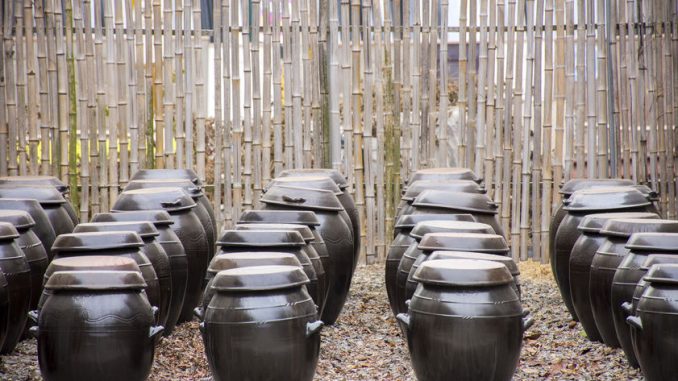
Doenjang is a traditional Korean food and is widely used in most of that country’s recipes either as a main ingredient, as a condiment, or as a sauce for Korean dishes. It is made by a fermentation process; therefore, it has very versatile flavor characteristics which have now been characterised and profiled (Park et al., 1994). The flavour profile changes with the salt ageing of this paste (Lee et al., 2003).
Processing & Manufacture
The typical Doenjang making process involves Meju, which is the basis for its fermentation. Traditionally, Meju is made from the soaking, steaming, crushing, and fermenting of soybeans with natural microorganisms such as Bacillus subtillis, Rhizopus spp., and Aspergillus spp. (Jo et al., 2011). Doenjang is manufactured by fermentation of Meju, no longer than 2 to 3 months, and is then separated into 2 parts: the liquid part which is filtered to make soy sauce, and a solid fraction which is kept for further ripening, usually for longer than 2 months to make a traditional product (Park et al., 2002).
Manufacturing Doenjang by the traditional method takes more than 6 months, which can be a limitation for its mass production. Recently, a modified method was developed by food manufacturing companies for faster and more effective mass production of the product. In a modified, commercialized method, Meju fermentation was solely conducted by Bacillus subtilis to make koji, and koji was further ripened by Aspergillus oryzae. The use of controlled microflora and a standardized process could increase the production efficiency while maintaining the flavor consistency of Doenjang. However, it has been reported that when manufactured by this modified, commercialised method is characterised by slightly different sensory characteristics than Doenjang manufactured by the traditional method (Lee et al., 2003).
References
Jo, Y.J., Cho, I.H., Song, C.K., Shin, H.W., Kim, Y.S. (2011) Comparison of fermented soybean paste (Doenjang) prepared by different methods based on profiling of volatile compounds. J. Food Sci. 76(3):C368–79
Lee, G.G., Lee, H.D., Lee, C.H. (2003) Changes in sensory characteristics during salt aging of Doenjang (fermented soybean paste) made by different starters. Food Eng. Prog. 7 pp. 13–9.
Park, J.S., Lee, M.Y., Kim, K.S., Lee, T.S. (1994) Volatile flavor components of soybean paste (Doenjang) prepared from different types of strains. Korean J. Food Sci. Technol. 26 pp. 255–60.
Park, K.Y., Hwang, K.M., Jung, K.O., Lee, K.B. (2002) Studies on the standardization of Doenjang (Korean soybean paste) 1. Standardization of manufacturing method of Doenjang by literatures. J. Korean Soc. Food Sci. Nutr. 31 pp. 343–50.
Do you know of any suppliers of this soy sauce ? I’m looking for a type to go with our Dim Sum. Interesting article as well. I’ve looked at a few others and they always seem good. Like the web-site now you’ve changed it.
It has to be one of the weirdest sauces I ever have. My visit to Korea meant lots of this sauce with everything.